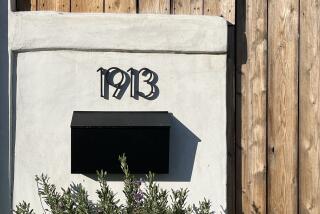Empty Florida homes may return to nature
- Share via
TAMPA, FLA. — The Georgetown apartment complex was one of this city’s most coveted properties back in 2005. Now Greg Chelius and Alex Size were touring it as if examining an exotic ruin.
They walked past the unmanned guardhouse and its broken windows. Size snapped photos with a digital camera. Chelius lifted the green fabric on a fence tacked with No Trespassing signs.
Building after building loomed in the near distance, all of them quiet and vacant. From Chelius’ vantage, it was difficult to judge their condition.
“We heard they were in such bad shape they’d have to be taken down,” he said.
“It depends on the drywall,” Size replied. “And the rot. And the mold.”
They walked the eastern edge of the property, stopping at a place where they could glimpse -- through a thicket of weeds and Brazilian pepper trees -- the blue water of Old Tampa Bay, lapping at the property’s edge.
As if on cue, a circling pelican dive-bombed for a fish.
“It’s just outstanding,” Chelius said.
These two men have big plans for the Georgetown property, 160 acres on the southwest side of the Tampa peninsula. But they are not planning to build.
Chelius is state director for the Trust for Public Land. Size is from the nonprofit’s St. Petersburg office. Because of the steep decline in property values here, they believe they have a chance to help local government purchase and preserve this stretch of waterfront. A few months ago, it was slated to be covered with luxury condominiums, “mansion” town houses and single-family homes.
Instead, Chelius and Size spoke about the native plants that could be restored -- the sabal palmetto palm, the seagrape trees, the three native species of mangrove. With the vegetation would come more native animals, more birds.
“We’re sort of like the un-developers right now,” Chelius said, smiling.
Florida and California are what Gary R. Mormino, a historian at the University of South Florida in Tampa, calls the two great American “dream states,” where surf and sunshine have lured generations with the promise of a better life.
Where Americans dare to dream, they have also dared to gamble on real estate, and the history of both states has been shaped by cycles of boom and bust.
Florida’s dream-state status has led to intense fluctuations in the value of its land, and the fortunes of those who would gamble on it: One historian of the 1920s housing bubble there called it the “greatest speculative frenzy in history.” More recently, an analyst at Goldman Sachs called Florida the “epicenter” of the nation’s current housing bust.
Georgetown was the kind of dream that defined much of Florida’s post-World War II growth -- a workingman’s idyll, paradise on the cheap.
Built in the early 1960s by a child of the Great Depression named Ralph Kaul, it offered a clean, if unassuming, place to live and modest rents. There was a swimming pool, a clubhouse and a plain-Jane marina -- and of course that postcard-perfect view of the bay.
By 2005, however, a more glamorous Florida dream fueled by borrowed money and unbridled optimism was set to overtake Georgetown.
Few imagined that the new dream would dissolve so spectacularly. By 2007, the state led the nation in foreclosures and unsold inventory, and neighborhoods like southwest Tampa were left with half-realized and abandoned projects.
A development planned for a few blocks away, called New Port, still has a website that promises “restaurants and cafes, residential balconies, boutiques, offices, verdant parklands, gardens, trails. . . .” Today it is in foreclosure; the land is an empty lot. Nearby, work on the gated Westshore Yacht Club has been indefinitely suspended. The developer is in bankruptcy.
And then there is Georgetown, which could now revert -- at least in part -- to the untended field of mangroves that it was when Ralph Kaul first laid eyes on it.
--
Kaul’s widow sold the Georgetown apartments at the market’s dizzying peak. The place isn’t her problem anymore. Yet Virginia Kaul bristles with frustration when she drives by.
“I have to keep telling myself, ‘We don’t own it anymore,’ ” she said. “But I wish they had torn it down. It’s just sad.”
Ralph Kaul, an experienced developer from the Washington, D.C., suburbs, began looking for places to build in Florida after losing a 1960 race for an Arlington, Va., congressional seat.
He arrived in Tampa at a time when the city was struggling to grow into a major metropolis. The region’s signature cigar industry had been on the wane for decades, and civic leaders were campaigning for new kinds of business.
They didn’t have trouble luring people. During World War II, soldiers stationed at MacDill Airfield, at the tip of the Tampa peninsula, got a taste of the sun and the sand. After the war, many returned, and other Americans followed.
Tampa didn’t have many large apartment complexes, so Kaul decided to build one. He spent $1 million on an empty tract on the western side of the Tampa peninsula, next to a trailer park.
The first phase of Georgetown was a row of brick town houses with colonial touches. It was a hit from the start, attracting young families and empty nesters, government workers and grocery clerks.
“They had a waiting list a mile long, and a screening process,” recalled Diana Watson, 71, who moved to Georgetown in 1974. “The apartments were beautiful, big and nice. . . . We loved it there.”
Kaul married Virginia in 1976, two years after the death of his first wife, and moved to Florida full time. He was a wealthy man; they could have lived anywhere. But he preferred to live among his tenants in a Georgetown apartment. He built hundreds more units, and filled in enough of the bay to effectively triple his acreage.
Kaul died at Georgetown in 2002. And Virginia watched as Tampa’s real estate soared. Middle-class homeowners were doubling their money on housing, then buying more property in hopes of doubling it again.
Developers turned their attention to southwest Tampa, one of the last stretches of waterfront that had not yet been upscaled and super-sized. Georgetown became the subject of a fierce bidding war. Bill Eshenbaugh, a real estate agent who calls himself “The Dirt Dog,” got cocky when a client offered $100 million.
“I thought someone would send a limo to take me to lunch for that offer,” he recalled. “All I got was a phone call from the broker, who said, ‘You’re not even close.’ ”
The winning bid of $125 million was submitted in April 2005 by a group of Delaware-based limited partnerships. Their public face was the Motta Group, a Fort Lauderdale developer with experience building luxury resorts.
Their plan was to tear down Georgetown and replace it with a “true waterfront retreat” called the Westshore Beach Club, with more than 1,200 condos and town homes. Its high-end buildings would be built in a neo-traditional Southern cottage style.
Meanwhile, the market was getting shaky. Eshenbaugh said speculators across Tampa had begun canceling contracts for unbuilt condos months earlier; by 2007, he said, “it was full-blown panic on the residential side.”
In September 2008 -- 11 months after the new owners emptied Georgetown of its tenants -- their lenders, a consortium of four banks including LaSalle Bank NA (now owned by Bank of America) began foreclosure proceedings, later accusing the owners of failing to make payments on their $89-million loan. The banks bought back the property in December, paying little more than $2 million at a bankruptcy auction.
--
Chelius, of the Trust for Public Land, hopes Bank of America will agree to split up the Georgetown property and let county taxpayers buy the bayfront portion to preserve as a park.
A private developer could buy the buildings, he said, fix them up and rent them as “workforce housing” -- until the market for luxury homes eventually picks up again.
Hillsborough County voters recently extended an environmental lands acquisition program that has been in place since 1987, allowing for the purchase of 6.5% of the land in the county.
Much of that has been in rural areas. City officials say Georgetown is a rare chance to pick up land in the city -- and, even more remarkably, along the water.
“The vast majority of our waterfront has been captured for development,” said Mark Huey, Tampa’s economic development administrator. “I mean -- look at our downtown. It’s bounded on three sides by water, but you’d have a hard time getting to it.”
Kaul’s daughter doesn’t know what her father would make of the idea of Georgetown becoming a park. “His background was in economics,” Judith Kaul said. “He was a realist. . . . He wasn’t an environmentalist.”
As Chelius walked back to Size’s Toyota Prius, he alluded, a little mischievously, to the fact that the federal government is now the largest investor in Bank of America, having given the company billions in recent months to help it manage its bad debt.
“It would be nice to have the public benefit from those dollars,” Chelius said.
He didn’t know what the property was worth, but he assumed that it was “losing value every day.” The bank would be wise to sell soon, he said.
He also acknowledged that the environmentalists would need to act fast. In a past life, Chelius was a Florida real estate agent.
He knows that sooner or later, a property like this one will get hot again.
--
More to Read
Inside the business of entertainment
The Wide Shot brings you news, analysis and insights on everything from streaming wars to production — and what it all means for the future.
You may occasionally receive promotional content from the Los Angeles Times.










